Many seniors want to know the most effective ways of taking care of those knees, especially when they’re not feeling their best. You know, knee pain can be such a downer, but don’t worry, we’ve got your back.
Well, technically, your knees are a very sensitive area especially when it hurts! Still, there are some leg exercises that aid these pain effectively without causing any issue.
Today, we’re going to learn about the “Best Leg Exercises For Bad Knees”. These exercises aren’t just about building strength; they’re about finding relief and improving mobility.
So, if you’ve been struggling with knee issues, whether it’s due to injury or just wear and tear, you’re in the right place. We’ll explore gentle yet effective movements that target key muscles without putting extra stress on those precious knee joints.
Stick with me, and together, we’ll discover ways to strengthen and support your knees, so you can move with more ease and comfort. Ready to get started? Let’s do this!
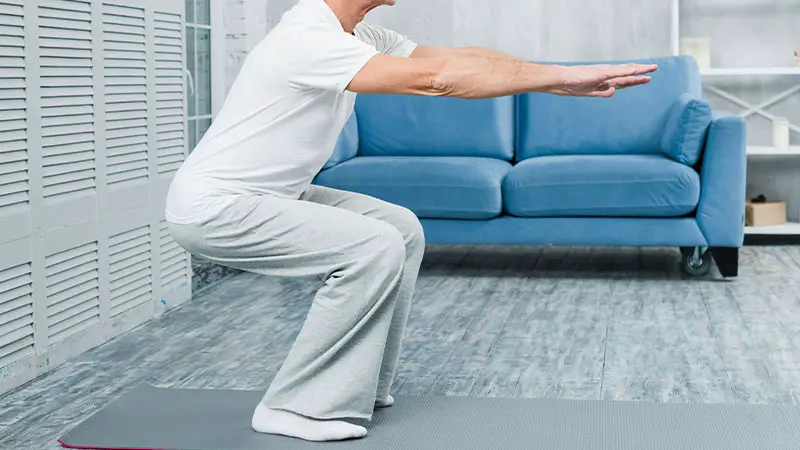
How Leg Exercises Heals Bad Knees?
Before we start learning about the best leg exercises for bad knees, we should learn how these exercises actually work. Here are some key points to consider:
Muscle Strengthening
When we engage in targeted leg exercises, we’re not just working on our quads or hamstrings; we’re also strengthening the muscles surrounding the knee joint. This added muscle support helps stabilise the knee, reducing strain and discomfort.
Improved Joint Function
By strengthening the muscles around the knee, we’re essentially providing better support for the joint itself. This improved support can enhance joint function, making movements smoother and more comfortable.
Reduced Stress on the Knee Joint
Weak muscles can put extra pressure on the knee joint, leading to pain and discomfort. Leg exercises help distribute the workload more evenly across the leg muscles, reducing the stress on the knee joint and promoting healing.
Enhanced Flexibility and Range of Motion
Regular leg exercises can also improve flexibility and range of motion in the knee joint. This increased flexibility allows for smoother movements and reduces the risk of stiffness or discomfort.
Prevention of Future Injuries
Strong, well-conditioned leg muscles are less prone to injury. By incorporating leg exercises into our routine, we’re not only addressing current knee issues but also working proactively to prevent future injuries.
Promotion of Overall Joint Health
Lastly, engaging in leg exercises doesn’t just benefit the knees; it promotes overall joint health. Strong muscles and improved joint function can contribute to better mobility, balance, and overall well-being.
Leg exercises play a crucial role in healing bad knees by strengthening muscles, improving joint function, reducing stress on the knee joint, enhancing flexibility, preventing future injuries, and promoting overall joint health.
So, if you’ve been dealing with knee issues, don’t underestimate the power of a good leg workout!
7 Best Leg Exercises For Bad Knees
Seniors, rejoice! We’ve curated a lineup of gentle yet effective leg exercises tailored specifically for those with bad knees. From supine straight leg lifts to seated leg extensions, these workouts prioritise safety and strength.
Let’s check them out more elaborately:
1. Supine Straight Leg Lifts

Supine straight leg lifts are gentle on the knees while effectively targeting the quadriceps and hip flexors. For seniors with bad knees, this exercise provides an opportunity to strengthen key muscle groups without putting undue stress on the knee joint.
How to try the workout:
- Lie on your back with legs extended.
- Lift one leg off the ground a few inches, holding for 10 seconds, then release.
- Repeat ten times for each leg, focusing on controlled movements.
- To increase difficulty, use ankle weights or resistance bands.
2. Banded Leg Extension
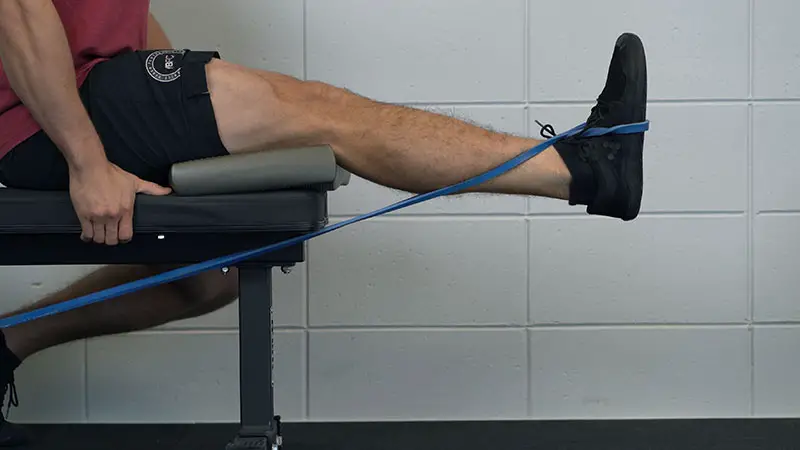
Banded leg extensions allow seniors to strengthen the quadriceps without putting excessive strain on the knees. The resistance band provides gentle yet effective resistance, making it suitable for those with knee issues.
How to try the workout:
- Sit on a chair with a small loop band around both ankles.
- Press one foot forward, extending the knee while squeezing the quadriceps.
- Repeat ten times for each leg, maintaining control throughout the movement.
- Adjust the resistance of the band as needed to challenge yourself appropriately.
3. Inner Thigh Squeeze
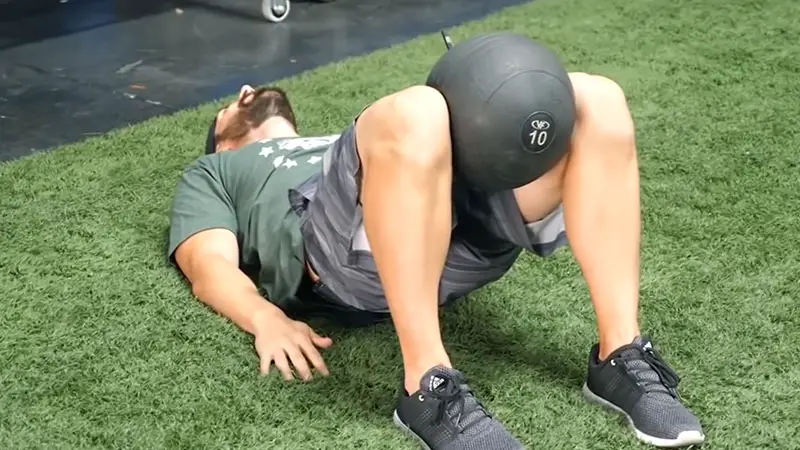
Inner thigh squeezes help strengthen the adductor muscles while promoting stability in the hip and knee joints. This exercise can be particularly beneficial for seniors who may experience weakness in the inner thigh area.
How to try the workout:
- Sit on a chair with feet flat on the ground and a ball or towel between your knees.
- Squeeze the ball or towel with your inner thighs, holding for a few seconds.
- Release and repeat ten times, focusing on engaging the inner thigh muscles.
- Increase the intensity by using a firmer ball or towel.
4. Body Bar Inner Thigh Lift

Body bar inner thigh lifts target the inner thigh muscles while providing support for the hips and knees. Seniors can perform this exercise lying down, reducing the risk of injury while still reaping the benefits of inner thigh strengthening.
How to try the workout:
- Lie on your side with a body bar placed in front of you.
- Lift the top leg upward, focusing on engaging the inner thigh muscles.
- Lower the leg back down with control and repeat ten times.
- Switch sides and perform the same movement for the opposite leg.
5. Standing Hip Hinge

Standing hip hinges strengthen the hamstrings and glutes while improving hip mobility. This exercise can help seniors maintain proper posture and reduce the risk of falls by enhancing stability and balance.
How to try the workout:
- Stand upright with feet shoulder-width apart and a slight bend in the knees.
- Hinge forward from the hips while keeping the spine straight and chest lifted.
- Engage the hamstrings and glutes as you return to the starting position.
- Repeat for ten repetitions, focusing on smooth and controlled movements.
6. Low Plank Hold with Knee Flexion
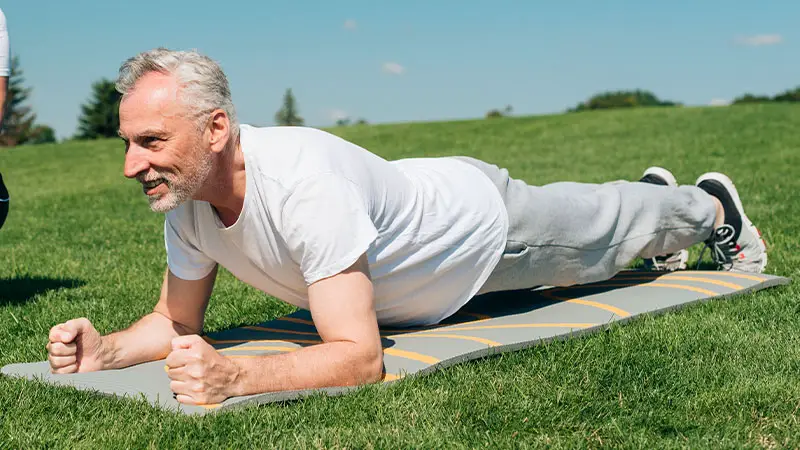
Low plank holds with knee flexion target the core, hips, and quadriceps while also improving balance and stability. This exercise can help seniors build strength in the entire lower body while minimising stress on the knees.
How to try the workout:
- Start in a low plank position with elbows directly under the shoulders and forearms on the ground.
- Lift one leg off the ground and flex the knee, bringing the heel towards the glute.
- Extend the leg back out and repeat on the opposite side.
- Aim for 8 to 12 repetitions on each leg, maintaining proper plank form throughout.
7. Seated Leg Extension
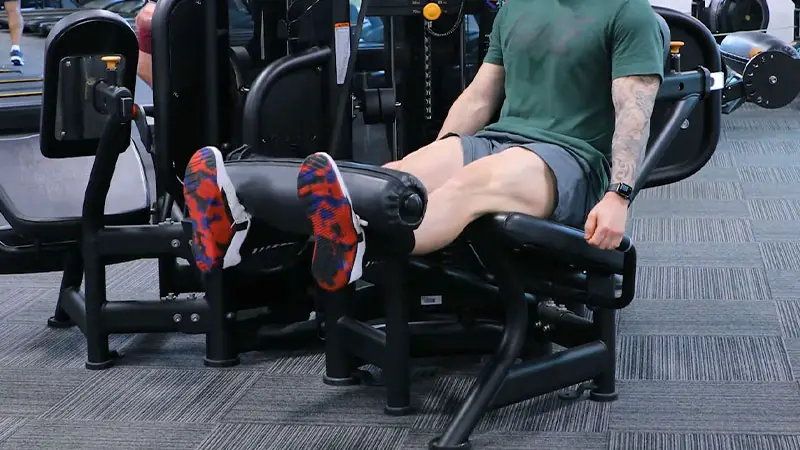
Seated leg extensions isolate the quadriceps while providing support for the lower back and knees. This exercise can help seniors improve knee strength and stability without the need for additional equipment.
How to try the workout:
- Sit in a chair with feet flat on the ground and knees bent at a 90-degree angle.
- Extend one leg forward until it’s parallel to the ground, then slowly lower it back down.
- Repeat for 8 to 12 repetitions on each leg, focusing on controlled movements.
- To increase the challenge, add ankle weights or hold onto a light dumbbell.
These seven leg exercises offer seniors a variety of options for strengthening key muscle groups while minimising stress on the knees.
Incorporating these exercises into a regular workout routine can help improve knee health, reduce pain, and enhance overall strength and mobility.
Remember to start slowly and gradually increase intensity to avoid overexertion, and always consult with a healthcare professional before beginning any new exercise program.
What Type Leg Exercises Are Not Suitable for Seniors?
Seniors can benefit greatly from a well-rounded exercise routine that includes a variety of movements. Engaging in different types of exercises helps improve overall fitness, maintain muscle strength, enhance flexibility, and promote cardiovascular health.
Additionally, trying new activities can keep workouts interesting and enjoyable, increasing adherence to an exercise regimen.
Exploring various exercises also allows seniors to target different muscle groups and address specific fitness goals. For example, incorporating resistance training can help maintain bone density and muscle mass, while cardiovascular exercises improve heart health and endurance.
Flexibility exercises, such as yoga or tai chi, can enhance range of motion and reduce the risk of injury. However, as a senior, you shouldn’t try just any type of leg exercises.
Here are the Leg Exercises that are not suitable for Seniors:
Jumping Squats
High-impact exercises like jumping squats can put excessive stress on the joints, including the knees, hips, and ankles. Seniors with existing knee issues or joint pain should avoid these activities to prevent further injury.
Heavy Barbell Squats
While squats are beneficial for building lower body strength, heavy barbell squats may not be suitable for seniors due to the potential risk of injury.
Lifting heavy weights can strain the muscles and joints, increasing the likelihood of muscle strains or joint pain.
High-Intensity Interval Training (HIIT)
HIIT workouts often involve rapid and intense movements, which may be too demanding for seniors, especially those with underlying health conditions or mobility limitations.
The high intensity of these workouts can increase the risk of overexertion and injury.
Plyometric Exercises
Plyometric exercises, such as box jumps or lateral jumps, require quick and explosive movements that may be challenging for seniors to perform safely.
These exercises can place excessive strain on the joints and increase the risk of falls or muscle strains.
Running or Jogging on Hard Surfaces
While running or jogging can be excellent forms of cardiovascular exercise, seniors should avoid doing so on hard surfaces like pavement or concrete.
The impact of repetitive pounding on hard surfaces can lead to joint pain and discomfort, particularly in the knees and hips.
Deep Lunges
Deep lunges require significant flexibility and strength, which may be difficult for seniors to achieve safely. Performing deep lunges can place excessive strain on the knees and hips, increasing the risk of injury or aggravating existing joint issues.
It’s important for seniors to prioritise exercises that are gentle on the joints, promote stability and balance, and can be adapted to individual fitness levels.
Always consult with a healthcare professional or certified trainer before starting a new exercise program, especially if you have any underlying health concerns or mobility limitations.
Things to Consider While Performing Leg Exercises For Bad Knees
When performing leg exercises for bad knees, there are several important factors to consider to ensure safety and effectiveness:
- Proper Form: Maintaining correct form during exercises is crucial to prevent unnecessary strain on the knees and maximise the benefits of the workout.
- Low-Impact Movements: Choose exercises that are gentle on the knees, such as those that involve controlled movements and minimal impact. Avoid high-impact activities that may exacerbate knee pain or cause further injury.
- Gradual Progression: Start with light weights or resistance and gradually increase intensity to avoid exacerbating knee pain.
- Range of Motion: Perform exercises through a comfortable range of motion to prevent overstretching or straining the knee joints. Avoid forcing movements beyond your body’s natural capabilities, as this can increase the risk of injury.
- Consultation: If experiencing severe knee pain or have a history of knee injuries, consult a healthcare professional or physical therapist before starting any new exercise routine.
- Listen to Your Body: Pay attention to any discomfort or pain during exercises and modify or stop if necessary to prevent injury.
- Warm-Up and Cool Down: Always warm up before exercising to prepare the muscles and joints, and cool down afterward to aid in recovery and reduce stiffness.
By considering these factors and incorporating them into your leg exercise routine, you can safely and effectively strengthen the muscles around your knees, improve joint function, and alleviate knee pain.
Remember to listen to your body, prioritise proper form, and consult with a healthcare professional if you have any concerns or questions about your exercise regimen.
Wrapping Up
Prioritizing the health of our knees through targeted exercise is paramount, especially for individuals with knee issues.
The carefully curated selection of leg exercises for bad knees offers not only relief from discomfort but also a pathway to improved strength, mobility, and overall well-being.
By focusing on low-impact movements, gradual progression, and proper form, individuals can effectively strengthen the muscles surrounding the knee joint while minimising the risk of exacerbating existing pain or injuries.
Moreover, incorporating these exercises into a regular routine provides a foundation for long-term knee health and resilience. From supine straight leg lifts to seated leg extensions, each workout offers unique benefits tailored to the needs of individuals with bad knees.
By embracing these exercises and following the recommended guidelines, individuals can reclaim control over their knee health and enjoy a more active and fulfilling lifestyle.
Remember, consistency and patience are key, and always consult with a healthcare professional before embarking on any new exercise regimen. Together, let’s prioritise the health and vitality of our knees for a happier, more active future.
I am a fitness instructor and I have been in the industry for 9 years. I have a passion for health and fitness.
I am a fitness instructor with over 9 years of experience in the industry. My passion is health and fitness and I would love to share my knowledge with you!